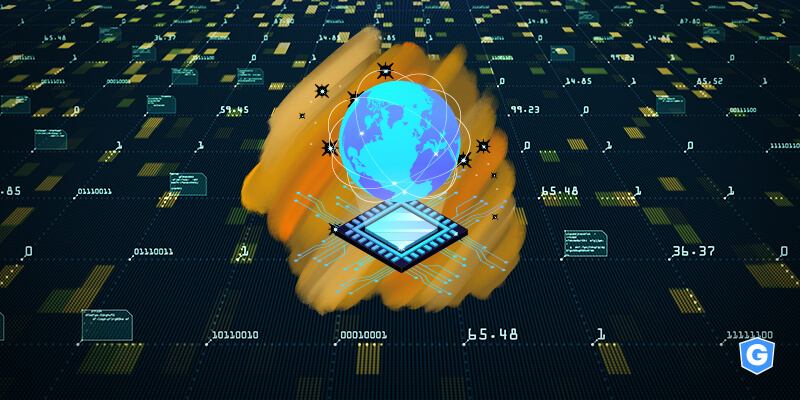How machine learning is related to big data

Machine learning and big data have a crucial relationship within technology processes, including cybersecurity. By themselves these tools are already major advances for the cyber world, but when used together they can offer even better results.
First, before we talk a little more about this union, let’s quickly clarify a little more about each of the concepts.
Machine learning is a method of analyzing data and information in such a way that systems learn from it and evolve on their own, eliminating or reducing the need for human intervention. These analysis methods are also known as algorithms.
It’s also important to say that machine learning is the basis of artificial intelligence systems.
The term big data, in short, refers to the way data and information are collected, stored, categorized and updated today.
In an increasingly connected world, with so many devices exchanging information with each other all the time, big data has been much discussed and gaining more prominence. After all, the information comes in impressive volume, variety and speed.
That’s why one of the most important questions about big data is precisely this: How do you process and make useful predictions with all this data, as traditional tools can’t handle so much data volume, variety and speed?
This is where machine learning and big data complement each other.
Table of Contents

What machine learning gains from big data
A machine learning algorithm can perfectly work with a smaller database. There are no problems with that. When it’s combined with big data, though, the magic happens as results are maximized.
A machine learning model learns more and faster when it’s fed by a large and varied volume of data and information.
This way, machine learning can find in big data patterns and anomalies that can solve problems and even create new insights, allowing technologies and companies to evolve.
That is, thanks to the volume of data and the speed with which it arrives, the actions to be determined by machine learning become more accurate and relevant.
What big data gains from machine learning
In turn, machine learning is one of the best ways to bring big data to life. Such a large volume of data is useful only to the extent that data can be effectively analyzed, correlated and transformed into effective actions.
This is actually the main role of machine learning in this case. After all, there’s no point in having data volume, variety, and speed if you can’t process it and especially add value to it.
In other words, we need to find quality and meaning in the midst of so much data. Information needs to become productive.
In this way, machine learning and big data work together to create intelligent models that have the ability to make relationships, predict behaviors and even determine actions. Yes, now we are talking about artificial intelligence.
5 real examples of machine learning and big data working together
1. Cybersecurity
Of course, our first topic has to be cybersecurity. We love talking about it. That said, the alliance between machine learning and big data is today an indispensable factor in the information security world.
After all, cyber attacks are becoming bolder and more sophisticated. Therefore, security solutions must be able to anticipate to quickly address known and unknown threats such as zero-day attacks.
For example, when it comes to email security, as is the case here at Gatefy, machine learning and big data come together so that our solution can predict and prevent attacks and threats.
With advanced algorithms that analyze massive data from both legitimate and malicious email, it’s possible to predict and identify risky, dangerous behaviors, separating the chaff from the wheat.
This analytics capability is essential to prevent phishing, spear phishing and ransomware attacks. That’s because these scams are increasingly using social engineering and spoofing tactics to try to pose as legitimate and harmless emails, thus circumventing traditional protection filters.
That’s why we say and repeat: machine learning and big data are essential when it comes to information security. To learn more, check out our email security solution or email gateway for companies: Gatefy Email Security.
2. Supply chain
The supply chain has been and continues to be transformed by the union of big data and machine learning. The use of these technologies today enables greater visibility, prediction, and control of the many factors that can affect an entire supply chain.
With big data and machine learning, it’s possible, for example, to anticipate and predict issues related to demand, production, inventory control, delays and even impacts caused by external events such as strikes and natural phenomena.
Similarly, data analyzed using machine learning can point out bottlenecks and errors in the logistics network, allowing for quick corrections. It’s wonderful, isn’t it?
3. Recommendation systems
This is one of my favorite topics when it comes to machine learning and big data. Do you know that classic Netflix email recommending a series that they think you’ll enjoy?
This is yet another form of joint action using machine learning and big data. The so-called recommendation systems are also used by countless other companies like Spotify, Amazon and Youtube.
Basically, recommendation systems cross large amounts of data (yours and from other users with a similar profile) to provide personalized recommendations.
Among the data collected are, for example, the types of content and products searched, what was actually watched or purchased, the time spent on the platform and at what times, etc.
The goal is to try to predict and deliver the products and content most likely to drive engagement. Thus, systems improve the user experience and provide more financial return to companies.
4. Dynamic pricing
Dynamic pricing is another practice that today is primarily done with the help of machine learning algorithms that analyze large volumes of data to determine price changes for products and services.
Systems analyze user behavior, demand at the time of purchase, historical demand for a given period, user engagement with a specific ad or marketing campaign, among many other factors.
Thus, they can predict demand, likelihood of purchase and user urgency to then determine prices, increase values or offer discounts.
The practice of dynamic pricing is widely adopted in the market, with classic examples being Uber, Cabify, 99 and Grab. Travel agencies, car rental companies and airlines also make use of this tactic.
5. Preventive equipment maintenance
Another use for systems that combine big data and machine learning is to predict possible errors and failures in machinery, alerting to the need for preventive maintenance.
To do so, the systems analyze basic machine data, such as year of manufacture and model, as well as information coming from the sensors every second, such as temperature, humidity and pressure readings.
Thus, it’s possible to identify patterns that lead to failures and alert when there is a need to correct something preemptively.
Conclusion
You now have a clear idea of the many ways through which big data and machine learning complement each other. This is a marriage that is here to stay. In cybersecurity, this partnership is increasingly beneficial and necessary, and is therefore a priority here at Gatefy.
That’s why we like to talk about this subject. If you would like to know more about how we use these technologies and how this can benefit your business, please contact us. We are available to answer all your questions.




